At a glance: The world right now
As central banks become increasingly hawkish and geopolitical risks build, we look at the latest developments in the global economy and what they mean for our forecasts
United States
The steep fall in mobility and consumer spending in December and January reflects Covid caution and threatens economic contraction in the first quarter. But as the Omicron wave passes, strong underlying fundamentals point to a rapid recovery that will set the Federal Reserve on the path of five rate hikes in 2022
Eurozone
The eurozone recovery is hitting a soft patch on the back of Omicron and high energy prices, but it should gain speed again from the second quarter onwards. The more lasting inflation story is pushing the European Central Bank towards a gradual change of tone. Net asset purchases are likely to end in September, leaving the door open for a rate hike by year-end.
United Kingdom
The UK is past the worst of Omicron and the economic impact has been fairly modest. Like Europe, the recovery faces a new test in the form of falling disposable incomes. But the Bank of England is focused squarely on inflation. The Bank has hiked rates twice and has begun the process of shrinking its balance sheet. We expect two further rate rises this year.
China
China is reporting 50 confirmed Covid cases per day as its population prepares to celebrate the Chinese New Year. Localised social distancing measures are tight in Beijing, which will hurt catering businesses, but some consumption items will benefit. Luckily, infrastructure investment should take off after the holiday.
Asia ex-China
Compared to other parts of the world, policy rates in Asia are barely moving. Most central banks in the region are hanging on to their growth-supportive monetary stances, and rates in China are actually being cut. Inflation has not shot up as fast or as far as it has in Europe or the US, requiring less pushback from policymakers.
Central and Eastern Europe (CEE)
There is a higher risk of inflation staying elevated across the CEE region than in the developed EU economies, as the labour markets remain tight and the expansionary fiscal stance overlaps second-round effects from energy prices. This reinforces our view that the tightening cycle the CEE3 central banks have started will continue, albeit at different speeds.
Commodities
As tensions between Russia and Ukraine grow, so does the risk that it spills over into global commodity markets. A conflict against the two nations and/or tough sanctions against Russia has the potential to significantly tighten commodity markets. The European natural gas market is most vulnerable.
FX
The dollar is near its cyclical highs as the Fed prepares to embark on a tightening cycle. Has all the good news been priced into the dollar and how will central bank balance sheet adjustments hit FX markets? We continue to think that the Fed terminal rate is prone to being re-priced higher over the coming months and that the dollar rally has a little further to run.
Rates
We expect the US 10yr to break above 2%, though we’re not calling for it to go much above 2.25%, as we acknowledge the demand effect which is robust and is likely to remain a factor. The euro 10yr swap rate should get to the 50-75bp area, or at the very least remain comfortably above 50bp (it’s not there just yet). And the 10yr German yield should not be dipping materially negative again.
Download
Download article
4 February 2022
ING Monthly: The masks, and the gloves, are coming off This bundle contains {bundle_entries}{/bundle_entries} articlesThis publication has been prepared by ING solely for information purposes irrespective of a particular user's means, financial situation or investment objectives. The information does not constitute investment recommendation, and nor is it investment, legal or tax advice or an offer or solicitation to purchase or sell any financial instrument. Read more
